Humanitarian aid
Humanitarian aid is material and logistic assistance to people who need help. It is usually short-term help until the long-term help by the government and other institutions replaces it. Among the people in need are the homeless, refugees, and victims of natural disasters, wars, and famines. Humanitarian aid is material or logistical assistance provided for humanitarian purposes, typically in response to humanitarian relief efforts including natural disasters and man-made disaster. The primary objective of humanitarian aid is to save lives, alleviate suffering, and maintain human dignity. It may, therefore, be distinguished from development aid, which seeks to address the underlying socioeconomic factors which may have led to a crisis or emergency. There is a debate on linking humanitarian aid and development efforts, which was reinforced by the World Humanitarian Summit in 2016. However, the approach is viewed critically by practitioners.[1]
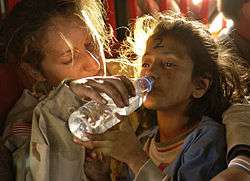
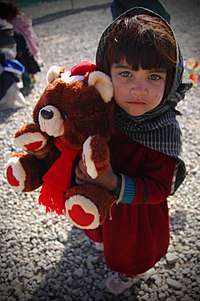
Humanitarian aid aims to bring short term relief to victims until long term relief can be provided by the government and other institutions. Humanitarian aid considers "a fundamental expression of the universal value of solidarity between people and a moral imperative".[2] Humanitarian aid can come from either local or international communities. In reaching out to international communities, the Office for the Coordination of Humanitarian Affairs (OCHA)[3] of the United Nations (UN) is responsible for coordination responses to emergencies. It taps to the various members of Inter-Agency Standing Committee, whose members are responsible for providing emergency relief. The four UN entities that have primary roles in delivering humanitarian aid are United Nations Development Programme (UNDP), the United Nations Refugee Agency (UNHCR), the United Nations Children's Fund (UNICEF) and the World Food Programme (WFP).[4]
According to The Overseas Development Institute, a London-based research establishment, whose findings were released in April 2009 in the paper "Providing aid in insecure environments:2009 Update", the most lethal year in the history of humanitarianism was 2008, in which 122 aid workers were murdered and 260 assaulted. The countries deemed least safe were Somalia and Afghanistan.[5] In 2014, Humanitarian Outcomes reported that the countries with the highest incidents were: Afghanistan, Democratic Republic of the Congo, Central African Republic, South Sudan, Sudan, Syria, Pakistan, Somalia, Yemen and Kenya.[6]
History
Origins
The beginnings of organized international humanitarian aid can be traced to the late 19th century. The most well-known origin story of formalized humanitarian aid is that of Henri Dunant, a Swiss businessman and social activist, who upon seeing the sheer destruction and inhumane abandonment of wounded soldiers from the Battle of Solferino in June 1859, canceled his plans and began a relief response.[7]
Prior to the work of Henri Dunant in Humanitarian Aid was that of Florence Nightingale. In 1854, the Crimean War began[8] Florence Nightingale and her team of 38 nurses arrived to Barracks Hospital of Scutari where there were thousands of sick and wounded soldiers.[9] Florence and her team watched as the understaffed military hospitals struggled to maintain hygienic conditions and meet the needs of patients.[8] Ten times more soldiers were dying of disease than from battle wounds.[10] Typhus, typhoid, cholera and dysentery were common in the army hospitals.[10] Florence and her team established a kitchen, laundry and increased hygiene. More nurses arrived to aid in the efforts and the General Hospital at Scutari was able to care for 6,000 patients.[9]
Nightingale's contributions still influence humanitarian aid efforts. This is especially true in regard to Nightingale's use of statistics and measures of mortality and morbidity. Nightingale used principles of new science and statistics to measure progress and plan for her hospital.[10] She kept records of the number and cause of deaths in order to continuously improve the conditions in hospitals.[11] Her findings were that in every 1,000 soldiers, 600 were dying of communicable and infectious diseases.[12] She worked to improve hygiene, nutrition and clean water and decreased the mortality rate from 60% to 42% to 2.2%.[12] All of these improvements are pillars of modern humanitarian intervention. Once she returned to Great Britain she campaigned for the founding of the Royal Commission on the Health of the Army.[11] She advocated for the use of statistics and coxcombs to portray the needs of those in conflict settings.[11]
</ref>[13] Despite little to no experience as a medical physician, Dunant worked alongside local volunteers to assist the wounded soldiers from all warring parties, including Austrian, Italian and French casualties, in any way he could including the provision of food, water, and medical supplies. His graphic account of the immense suffering he witnessed, written in his book “A Memory of Solferino", became a foundational text to modern humanitarianism.[14]
A Memory of Solferino changed the world in a way that no one, let alone Dunant, could have foreseen nor truly appreciated at the time. To start, Dunant was able to profoundly stir the emotions of his readers by bringing the battle and suffering into their homes, equipping them to understand the current barbaric state of war and treatment of soldiers after they were injured or killed; in of themselves these accounts altered the course of history.[15] Beyond this, in his two-week experience attending to the wounded soldiers of all nationalities, Dunant inadvertently established the vital conceptual pillars of what would later become the International Committee of the Red Cross and International Humanitarian Law: impartiality and neutrality.[16] Dunant took these ideas and came up with two more ingenious concepts that would profoundly alter the practice of war; first Dunant envisioned a creation of permanent volunteer relief societies, much like the ad hoc relief group he coordinated in Solferino, to assist wounded soldiers; next Dunant began an effort to call for the adoption of a treaty which would guarantee the protection of wounded soldiers and any who attempted to come to their aid.[17]
After publishing his foundational text in 1862, progress came quickly for Dunant and his efforts to create a permanent relief society and International Humanitarian Law. The embryonic formation of the International Committee of the Red Cross had begun to take shape in 1863 when the private Geneva Society of Public Welfare created a permanent sub-committee called “The International Committee for Aid to Wounded in Situations of War”; composed of five Geneva citizens, this committee endorsed Dunant's vision to legally neutralize medical personnel responding to wounded soldiers.[18][19] The constitutive conference of this committee in October 1863 created the statutory foundation of the International Committee of the Red Cross in their resolutions regarding national societies, caring for the wounded, their symbol, and most importantly the indispensable neutrality of ambulances, hospitals, medical personnel and the wounded themselves.[20] Beyond this, in order to solidify humanitarian practice, the Geneva Society of Public Welfare hosted a convention between 8 and 22 August 1864 at the Geneva Town Hall with 16 diverse States present, including many governments of Europe, the Ottoman Empire, the United States of America (USA), Brazil and Mexico.[21] This diplomatic conference was exceptional, not due to the number or status of its attendees but rather because of its very raison d'être. Unlike many diplomatic conferences before it, this conference's purpose was not to reach a settlement after a conflict nor to mediate between opposing interests; indeed this conference was to lay down rules for the future of conflict with aims to protect medical services and those wounded in battle.[22]
The first of the renowned Geneva Conventions was signed on 22 August 1864; never before in history has a treaty so greatly impacted how warring parties engage with one another.[23] The basic tenents of the convention outlined the neutrality of medical services, including hospitals, ambulances, and related personnel, the requirement to care for and protect the sick and wounded during the conflict and something of particular symbolic importance to the International Committee of the Red Cross: the Red Cross emblem.[24] For the first time in contemporary history, it was acknowledged by a representative selection of states that war had limits. The significance only grew with time in the revision and adaptation of the Geneva Convention in 1906, 1929 and 1949; additionally, supplementary treaties granted protection to hospital ships, prisoners of war and most importantly to civilians in wartime.[25]
The International Committee of the Red Cross exists to this day as the guardian of International Humanitarian Law and as one of the largest providers of humanitarian aid in the world.[26]
Another such examples occurred in response to the Northern Chinese Famine of 1876–1879, brought about by a drought that began in northern China in 1875 and lead to crop failures in the following years. As many as 10 million people may have died in the famine.[27]
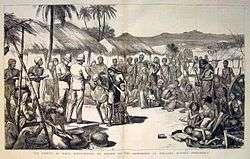
British missionary Timothy Richard first called international attention to the famine in Shandong in the summer of 1876 and appealed to the foreign community in Shanghai for money to help the victims. The Shandong Famine Relief Committee was soon established with the participation of diplomats, businessmen, and Protestant and Roman Catholic missionaries.[28] To combat the famine, an international network was set up to solicit donations. These efforts brought in 204,000 silver taels, the equivalent of $7–10 million in 2012 silver prices.[29]
A simultaneous campaign was launched in response to the Great Famine of 1876–78 in India. Although the authorities have been criticized for their laissez-faire attitude during the famine, relief measures were introduced towards the end. A Famine Relief Fund was set up in the United Kingdom and had raised £426,000 within the first few months.
1980s

Early attempts were in private hands and were limited in their financial and organizational capabilities. It was only in the 1980s, that global news coverage and celebrity endorsement were mobilized to galvanize large-scale government-led famine (and other forms of) relief in response to disasters around the world. The 1983–85 famine in Ethiopia caused upwards of 1 million deaths and was documented by a BBC news crew, with Michael Buerk describing "a biblical famine in the 20th Century" and "the closest thing to hell on Earth".[30]
Live Aid, a 1985 fund-raising effort headed by Bob Geldof induced millions of people in the West to donate money and to urge their governments to participate in the relief effort in Ethiopia. Some of the proceeds also went to the famine hit areas of Eritrea.[31]
2010s
The first global summit on humanitarian aid was held on 23 and 24 May 2016 in Istanbul, Turkey. An initiative of United Nations Secretary-General Ban Ki-moon, the World Humanitarian Summit included participants from governments, civil society organizations, private organizations, and groups affected by humanitarian need. Issues that were discussed included: preventing and ending conflict, managing crises, and aid financing.
Funding
Aid is funded by donations from individuals, corporations, governments and other organizations. The funding and delivery of humanitarian aid is increasingly international, making it much faster, more responsive, and more effective in coping to major emergencies affecting large numbers of people (e.g. see Central Emergency Response Fund). The United Nations Office for the Coordination of Humanitarian Affairs (OCHA) coordinates the international humanitarian response to a crisis or emergency pursuant to Resolution 46/182 of the United Nations General Assembly. The need for aid is ever-increasing and has long outstripped the financial resources available.[32]
Delivery of humanitarian aid

Humanitarian aid spans a wide range of activities, including providing food aid, shelter, education, healthcare or protection. The majority of aid is provided in the form of in-kind goods or assistance, with cash and vouchers constituting only 6% of total humanitarian spending.[33] However, evidence has shown how cash transfers can be better for recipients as it gives them choice and control, they can be more cost-efficient and better for local markets and economies.[33]
It is important to note that humanitarian aid is not only delivered through aid workers sent by bilateral, multilateral or intergovernmental organizations, such as the United Nations. Actors like the affected people themselves, civil society, local informal first-responders, civil society, the diaspora, businesses, local governments, military, local and international non-governmental organizations all play a crucial role in a timely delivery of humanitarian aid.[34]
Technology and humanitarian aid
Traditionally, humanitarian organizations have concentrated their efforts in the delivery of human, medical, food, shelter and water sanitation and hygiene resources during humanitarian emergencies.
Nevertheless, since the 2010 Haiti Earthquake, the institutional and operational focus of humanitarian aid has been on leveraging technology to enhance humanitarian action, ensuring that more formal relationships are established, and improving the interaction between formal humanitarian organizations such as the United Nations (UN) Office for the Coordination of Humanitarian Affairs (OCHA) and informal volunteer and technological communities known as digital humanitarians.[35]
The recent rise in Big Data, high-resolution satellite imagery and new platforms powered by advanced computing have already prompted the development of innovative computational solutions to help humanitarian organizations make sense of the vast volume and velocity of information generated during disasters. For example, crowdsourcing maps (such as Open Street Maps) and social media messages in Twitter were used during the 2010 Haiti Earthquake and Hurricane Sandy to trace leads of missing people, infrastructure damages and rise new alerts for emergencies.[36]
Satellite imagery is now used to predict how many people will be displaced from their homes and where they will likely move. Such insights helps emergency personnel to identify how much aid in terms of water, food and medical care will be needed and where to send it before they do a Rapid Needs Assessment on the field, and at the same time it helps to prevent to put in risk the humanitarian organization personnel. Artificial intelligence algorithms may instantaneously assess flooding, building and road damage based on satellite images and weather forecasts, allowing rescuers to distribute emergency aid more effectively and identify those still in danger and isolated from escape routes.[37] Another example that illustrates technology used for humanitarian purposes is the Artificial Intelligence for Digital Response (AIDR) platform which is a free and open source software that automatically collects and classifies tweets that are posted during emergencies, humanitarian crises and disasters. AIDR uses human and machine intelligence to automatically tag up to thousands of messages per minute so humanitarian organizations are able to take faster decisions depending on the trends from the data collected during a specific kind emergency.
Big data for humanitarian operations provides a unique opportunity to access instantaneously contextual information about pending and ongoing humanitarian crises. The development of rigorous information management systems may lead to feasible mechanisms for forecasting and preventing crises. Nevertheless, there are important issues to be discussed concerning the veracity and validity of data. Data that are collected or generated through digital or mobile mechanisms will often pose additional challenges, especially regarding the verification when the information comes from social media. Though a significant amount of work is under way to develop software and algorithms for verifying crowdsourced or anonymously provided data, such tools are not yet operational or widely available. Also, multiple data transactions and increased complexity in data structures raise the potential for error in humanitarian data entry and interpretation, and this raises concerns about the accuracy and representativeness of data that is used for policy decisions in highly pressurized situations that demand quick decision-making.[35]
Humanitarian aid and conflict
In addition to post-conflict settings, a huge portion of aid is being directed at countries currently undergoing conflicts.[38] However, the effectiveness of humanitarian aid, particularly food aid, in conflict-prone regions has been criticized in recent years. There have been accounts of humanitarian aid being not only inefficacious, but actually fueling conflicts in the recipient countries.[39] Aid stealing is one of the prime ways in which conflict is promoted by humanitarian aid. Aid can be seized by armed groups, and even if it does reach the intended recipients, "it is difficult to exclude local members of local militia group from being direct recipients if they are also malnourished and qualify to receive aid."[39] Furthermore, analyzing the relationship between conflict and food aid, a recent research shows that the United States' food aid promoted civil conflict in recipient countries on average. An increase in United States' wheat aid increased the duration of armed civil conflicts in recipient countries, and ethnic polarization heightened this effect.[39] However, since academic research on aid and conflict focuses on the role of aid in post-conflict settings, the aforementioned finding is difficult to contextualize. Nevertheless, research on Iraq shows that "small-scale [projects], local aid spending . . . reduces conflict by creating incentives for average citizens to support the government in subtle ways."[38] Similarly, another study also shows that aid flows can "reduce conflict because increasing aid revenues can relax government budget constraints, which can [in return] increase military spending and deter opposing groups from engaging in conflict."[40] Thus, the impact of humanitarian aid on conflict may vary depending upon the type and mode in which aid is received, and, inter alia, the local socio-economic, cultural, historical, geographical and political conditions in the recipient countries.
Aid workers
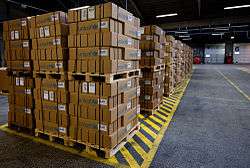
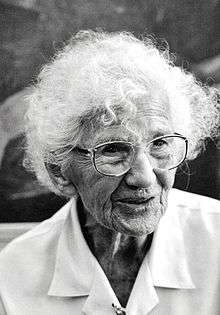
Aid workers are the people distributed internationally to do humanitarian aid work. They often require humanitarian degrees.
Composition
_166_(REIN)%2C_11th_Marine_Expeditionary_Unit_(MEU)_Special_Operations_Capable_(SOC).jpg)
The total number of humanitarian aid workers around the world has been calculated by ALNAP, a network of agencies working in the Humanitarian System, as 210,800 in 2008. This is made up of roughly 50% from NGOs, 25% from the Red Cross/ Red Crescent Movement and 25% from the UN system.[41]
The humanitarian fieldworker population has increased by approximately 6% per year over the past 10 years.
Psychological Issues
Aid workers are exposed to tough conditions and have to be flexible, resilient, and responsible in an environment that humans are not psychologically supposed to deal with, in such severe conditions that trauma is common. In recent years, a number of concerns have been raised about the mental health of aid workers.[42][43]
The most prevalent issue faced by humanitarian aid workers is PTSD (Post Traumatic Stress Disorder). Adjustment to normal life again can be a problem, with feelings such as guilt being caused by the simple knowledge that international aid workers can leave a crisis zone, whilst nationals cannot.
A 2015 survey conducted by The Guardian, with aid workers of the Global Development Professionals Network, revealed that 79 percent experienced mental health issues.[44]
Standards
During the past decade the humanitarian community has initiated a number of interagency initiatives to improve accountability, quality and performance in humanitarian action. Five of the most widely known initiatives are the Active Learning Network for Accountability and Performance in Humanitarian Action (ALNAP), Humanitarian Accountability Partnership (HAP), People in Aid, the Sphere Project and the Core Humanitarian Standard on Quality and Accountability (CHS). Representatives of these initiatives began meeting together on a regular basis in 2003 in order to share common issues and harmonise activities where possible.
People in Aid
The People in Aid Code of Good Practice is an internationally recognised management tool that helps humanitarian aid and development agencies enhance the quality of their human resources management. As a management framework, it is also a part of agencies’ efforts to improve standards, accountability and transparency amid the challenges of disaster, conflict and poverty.[45]
Humanitarian Accountability Partnership International
Working with its partners, disaster survivors, and others, Humanitarian Accountability Partnership International (or HAP International) produced the HAP 2007 Standard in Humanitarian Accountability and Quality Management. This certification scheme aims to provide assurance that certified agencies are managing the quality of their humanitarian actions in accordance with the HAP standard.[46] In practical terms, a HAP certification (which is valid for three years) means providing external auditors with mission statements, accounts and control systems, giving greater transparency in operations and overall accountability.[47][48]
As described by HAP-International, the HAP 2007 Standard in Humanitarian Accountability and Quality Management is a quality assurance tool. By evaluating an organisation's processes, policies and products with respect to six benchmarks setout in the Standard, the quality becomes measurable, and accountability in its humanitarian work increases.
Agencies that comply with the Standard:
- declare their commitment to HAP's Principles of Humanitarian Action and to their own Humanitarian Accountability Framework
- develop and implement a Humanitarian Quality Management System
- provide key information about quality management to key stakeholders
- enable beneficiaries and their representatives to participate in program decisions and give their informed consent
- determine the competencies and development needs of staff
- establish and implement complaints-handling procedure
- establish a process of continual improvement[49]
Sphere Project
The Sphere Project handbook, Humanitarian Charter and Minimum Standards in Disaster Response, which was produced by a coalition of leading non-governmental humanitarian agencies, lists the following principles of humanitarian action:
- The right to life with dignity
- The distinction between combatant and non-combatants
- The principle of non-refoulement
Core Humanitarian Standard on Quality and Accountability

Another humanitarian standard used is the Core Humanitarian Standard on Quality and Accountability (CHS). It was approved by the CHS Technical Advisory Group in 2014, and has since been endorsed by many humanitarian actors such as "the Boards of the Humanitarian Accountability Partnership (HAP), People in Aid and the Sphere Project".[50] It comprises nine core standards, which are complemented by detailed guidance notes and indicators.
While some critics were questioning whether the sector will truly benefit from the implementation of yet another humanitarian standard, others have praised it for its simplicity.[51] Most notably, it has replaced the core standards of the Sphere Handbook[52] and it is regularly referred to and supported by officials from the United Nations, the EU, various NGOs and institutes.[53]
Humanitarian Encyclopedia
The Humanitarian Encyclopedia, launched in June 2017, aims to create "a clear and comprehensive reference framework, influenced by local and contextualised knowledge … [including] analyses of lessons learned and best practices, as well as … insights for evidence-based decision and policy-making."[54] A part of this mission will be to provide a centralised data base for defining or clarifying different understandings of key concepts in humanitarian aid. The need for this stems from the experience in Haiti in the aftermath of the 2010 earthquake, where international aid organisations pushed out local aid groups as a result of a lack of reflection and understanding of local contexts and aid concepts, making the relief effort less efficient.[54]
Free to access, the project is expected to be completed within five years, with the first parts slated to be published online by the end of 2018.[54]
See also
- Attacks on humanitarian workers
- Christian humanitarian aid
- Hard Choices: Moral Dilemmas in Humanitarian Intervention
- Effective altruism
- Humanitarianism
- Humanitarian access
- Humanitarian principles
- Humanitarian Response Index
- International humanitarian law
- Timeline of events in humanitarian relief and development
- Vienna Declaration and Programme of Action
- World Humanitarian Day
- World Humanitarian Summit
References
- Sid Johann Peruvemba, Malteser International (31 May 2018). "Why the nexus is dangerous". D+C Development and Cooperation. Retrieved 13 August 2018.
- "The State of Art of Humanitarian Action, (PDF). EUHAP" (PDF). euhap.eu. Archived (PDF) from the original on 15 February 2017. Retrieved 28 April 2018.
- "OCHA". www.unocha.org. Archived from the original on 19 March 2018. Retrieved 28 April 2018.
- "Deliver Humanitarian Aid". www.un.org. 7 December 2014. Archived from the original on 19 March 2018. Retrieved 28 April 2018.
- "Archived copy" (PDF). Archived (PDF) from the original on 19 September 2011. Retrieved 13 December 2010.CS1 maint: archived copy as title (link)
- "Highest incident contexts (2012–2018)". Aid Worker Security Database. Humanitarian Outcomes. Archived from the original on 7 September 2015. Retrieved 11 December 2015.
- Haug, Hans. "The Fundamental Principles of the International Red Cross and Red Crescent Movement" (PDF). Retrieved 1 November 2019.
- Hosein Karimi, Negin Masoudi Alavi. Florence Nightingale: The Mother of Nursing. Nurs Midwifery Stud. 2015 Jun;4(2)
- Joseph H. Choate. What Florence Nightingale Did for Mankind. Am J Nurs. 1911 Feb;11(5):346–57.
- Elizabeth Fee, Mary E. Garofalo. Florence Nightingale and the Crimean War.
- Understanding Uncertainty. Florence Nightingale and the Crimean War.
- Hosein Karimi, Negin Masoudi Alavi. Florence Nightingale: The Mother of Nursing. Nurs Midwifery Stud. 2015 Jun;4(2).
- Forsythe, David. The Humanitarians: The International Committee of the Red Cross. (New York: Cambridge University Press, 2005), 15.
- Barnett, Michael, and Weiss, Thomas. Humanitarianism in Question: Politics, Power, Ethics. (New York: Cornell University Press, 2008), 101.
- Bugnion, Francois. "Birth of an Idea: The Founding of the International Committee of the Red Cross and of the International Red Cross and Red Crescent Movement: From Solferino to the Original Geneva Convention (1859–1864)." International Review of the Red Cross 94 (2013): 1306.
- Bugnion, Francois. "Birth of an Idea: The Founding of the International Committee of the Red Cross and of the International Red Cross and Red Crescent Movement: From Solferino to the Original Geneva Convention (1859–1864)." International Review of the Red Cross 94 (2013): 1303
- ugnion, Francois. "Birth of an Idea: The Founding of the International Committee of the Red Cross and of the International Red Cross and Red Crescent Movement: From Solferino to the Original Geneva Convention (1859–1864)." International Review of the Red Cross 94 (2013): 1300
- Forsythe, David. The Humanitarians: The International Committee of the Red Cross. (New York: Cambridge University Press, 2005), 17.
- Bugnion, Francois. "Birth of an Idea: The Founding of the International Committee of the Red Cross and of the International Red Cross and Red Crescent Movement: From Solferino to the Original Geneva Convention (1859–1864)." International Review of the Red Cross 94 (2013): 1311
- Bugnion, Francois. "Birth of an Idea: The Founding of the International Committee of the Red Cross and of the International Red Cross and Red Crescent Movement: From Solferino to the Original Geneva Convention (1859–1864)." International Review of the Red Cross 94 (2013): 1320.
- Bugnion, Francois. "Birth of an Idea: The Founding of the International Committee of the Red Cross and of the International Red Cross and Red Crescent Movement: From Solferino to the Original Geneva Convention (1859–1864)." International Review of the Red Cross 94 (2013): 1323.
- Bugnion, Francois. "Birth of an Idea: The Founding of the International Committee of the Red Cross and of the International Red Cross and Red Crescent Movement: From Solferino to the Original Geneva Convention (1859–1864)." International Review of the Red Cross 94 (2013): 1324
- Bugnion, Francois. "Birth of an Idea: The Founding of the International Committee of the Red Cross and of the International Red Cross and Red Crescent Movement: From Solferino to the Original Geneva Convention (1859–1864)." International Review of the Red Cross 94 (2013): 1325
- Bugnion, Francois. "Birth of an Idea: The Founding of the International Committee of the Red Cross and of the International Red Cross and Red Crescent Movement: From Solferino to the Original Geneva Convention (1859–1864)." International Review of the Red Cross 94 (2013):1325
- Bugnion, Francois. "Birth of an Idea: The Founding of the International Committee of the Red Cross and of the International Red Cross and Red Crescent Movement: From Solferino to the Original Geneva Convention (1859–1864)." International Review of the Red Cross 94 (2013):1326
- "Who we are". International Committee of the Red Cross. 28 July 2014. Retrieved 27 January 2020.
- Edgerton-Tarpley, Kathryn, "Pictures to Draw Tears from Iron" "Archived copy" (PDF). Archived from the original (PDF) on 18 May 2016. Retrieved 25 December 2013.CS1 maint: archived copy as title (link), accessed 25 December 2013
- Janku, Andrea (2001) "The North-China Famine of 1876–1879: Performance and Impact of a Non-Event." In: Measuring Historical Heat: Event, Performance, and Impact in China and the West. Symposium in Honour of Rudolf G. Wagner on His 60th Birthday. Heidelberg, 3–4 November, pp. 127–134
- China Famine Relief Fund. Shanghai Committee (1879). The great famine : [Report of the Committee of the China Famine Relief Fund]. Cornell University Library. [Shanghai : American Presbyterian Mission Press.
- "How a Report on Ethiopia's 'Biblical Famine' Changed the World". NBC News. 23 October 2014.
- "In 1984 Eritrea was part of Ethiopia, where some of the song's proceeds were spent". Archived from the original on 12 May 2009. Retrieved 8 May 2009.
- Hendrik Slusarenka (20 May 2018). "Aid in itself is not enough". D+C, development and cooperation. Retrieved 13 August 2018.
- [High Level Panel on Humanitarian Cash Transfers "Doing cash differently: How cash transfers can transform humanitarian aid". Archived from the original on 23 September 2015. Retrieved 21 September 2015. Doing cash differently: how cash transfers can transform humanitarian aid]
- Leaving no one behind : humanitarian effectiveness in the age of the sustainable development goals. Easton, Matthew,, United Nations. Office for the Coordination of Humanitarian Affairs,, Collaborative for Development Action., CDA Collaborative Learning Projects. [New York?]. 2016. ISBN 9789211320442. OCLC 946161611.CS1 maint: others (link)
- Sandvik, Kristin (December 2014). "Humanitarian Technology: A Critical Research Agenda". Research Gate. Retrieved 27 April 2020.
- Meier, Patrick (2015). Digital Humanitarians: How Big Data is Changing the Face of Humanitarian Response. E-Book: CRC Press Taylor & Francis Group. ISBN 978-1-4987-2652-8.
- Van Heteren, Ashley (14 January 2020). "Natural disasters are increasing in frequency and ferocity. Here's how AI can come to the rescue". World Economic Forum. Retrieved 27 April 2020.
- Berman, Eli; Felter, Joe; Shapiro, Jacob; Troland, Erin (26 May 2013). "Effective aid in conflict zones". VoxEU.org. Archived from the original on 23 May 2017.
- Nunn, Nathan; Qian, Nancy (2014). "US Food Aid and Civil Conflict" (PDF). American Economic Review. 104 (6): 1630–1666. doi:10.1257/aer.104.6.1630.
- Qian, Nancy (18 August 2014). "Making Progress on Foreign Aid". Annual Review of Economics. 3.
- "State of the Humanitarian System report" (PDF). ALNAP. 2010. p. 18. Archived from the original (PDF) on 14 December 2010.
- "Health – The university course giving aid to aid workers". BBC News. Archived from the original on 25 September 2015. Retrieved 11 December 2015.
- "Health – Aid workers lack psychological support". BBC News. Archived from the original on 26 December 2002. Retrieved 11 December 2015.
- "Guardian research suggests mental health crisis among aid workers". The Guardian. Archived from the original on 28 April 2017. Retrieved 27 April 2017.
- "Archived copy" (PDF). Archived from the original (PDF) on 8 May 2013. Retrieved 5 March 2012.CS1 maint: archived copy as title (link) – Background to the People in Aid Code of Good Practice
- Capacity.org Archived 5 September 2008 at the Wayback Machine – A Gateway for Capacity Development
- The Economist Archived 14 April 2009 at the Wayback Machine – Certifying Aid Agencies, 24 May 2007
- Reuters Alernet Website Archived 11 November 2009 at the Wayback Machine – Can a certificate make aid agencies better listeners? 6 June 2008
- HAP-International Website Archived 16 December 2009 at the Wayback Machine – The HAP 2007 Standard
- "Frequently Asked Questions – CHS". corehumanitarianstandard.org. Retrieved 6 November 2018.
- Purvis, Katherine (11 June 2015). "Core Humanitarian Standard: do NGOs need another set of standards?". the Guardian. Retrieved 6 November 2018.
- "The Sphere Project | New online course on the Core Humanitarian Standard | News". www.sphereproject.org. Retrieved 6 November 2018.
- "Statements of support – CHS". corehumanitarianstandard.org. Retrieved 6 November 2018.
- "What does 'shelterless' mean? Ask the humanitarian encyclopedia". Devex. Archived from the original on 19 June 2017. Retrieved 10 July 2017.
Bibliography
- James, Eric (2008). Managing Humanitarian Relief: An Operational Guide for NGOs. Rugby: Practical Action.
- Minear, Larry (2002). The Humanitarian Enterprise: Dilemmas and Discoveries. West Hartford, CT: Kumarian Press. ISBN 1-56549-149-1.
- Waters, Tony (2001). Bureaucratizing the Good Samaritan: The Limitations of Humanitarian Relief Operations. Boulder: Westview Press.
External links
- "Active Learning Network for Accountability and Performance". alnap.org.
- "AlertNet". alertnet.org.
- "APCN (Africa Partner Country Network)". apan.org.
- "CE-DAT: The Complex Emergency Database". cedat.be.
- "Centre for Safety and Development". centreforsafety.org.
- "The Code of Conduct: humanitarian principles in practice". International Committee of the Red Cross.
- "Doctors of the World". medecinsdumonde.org.
- "EM-DAT: The International Disaster Database". emdat.be.
- "The New Humanitarian". thenewhumanitarian.org.
- "Protection work during armed conflict and other situations of violence: professional standards". International Committee of the Red Cross.
- "The Center for Disaster and Humanitarian Assistance Medicine". CDHAM.org.
- "The ODI Humanitarian Policy Group". odi.org.uk.
- "UN ReliefWeb". reliefweb.int.
Critiques of humanitarian aid
- Greenaway, Sean. "Post-Modern Conflict and Humanitarian Action: Questioning the Paradigm". Journal of Humanitarian Assistance.
- Rieff, David; Myers, Joanne J. "A Bed for the Night: Humanitarianism in Crisis". Archived from the original on 30 March 2007.